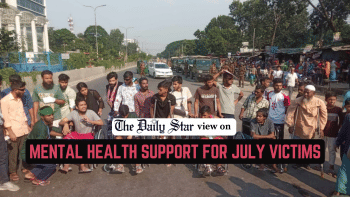Identify all martyrs of the July mass uprising

The delay in identifying hundreds of individuals killed during the July-August uprising is quite disappointing. According to a Prothom Alo report, 80 unclaimed bodies were buried in July and 34 in August at the burial ground adjacent to the Rayerbazar Mass Killing Site Memorial by the volunteer organisation Anjuman Mufidul Islam. Despite clear evidence that some of the graves at the cemetery contain the remains of those killed in the uprising, the exact number remains unknown.
Anjuman Mufidul Islam reported burying 515 unclaimed bodies between January and November, an average of 47 per month. In July, however, the number surged to 80. In August, 34 bodies were buried, with no burial requests made during the first 11 days due to the unrest. Identifying those who died in the protests requires investigation and DNA testing, but progress has been slow. As a result, many protest victims buried in Rayerbazar remain unidentified, leaving their families unable to locate their loved ones' graves or claim compensation. While some families have confirmed through personal efforts that their relatives were buried as unclaimed bodies at Rayerbazar, they remain unable to identify the specific graves.
One such victim is Mahin Mia. His brother, Abdul Jabbar, recounted that they had both participated in a protest at Town Hall in Mohammadpur on July 18. When Mahin did not return home, Abdul searched police stations and morgues in surrounding areas before learning, through photographs from Anjuman Mufidul Islam's office, that Mahin had been killed and buried in Rayerbazar. Fifteen days after Mahin's death, his wife gave birth to their only child.
One such victim is Mahin Mia. His brother, Abdul Jabbar, recounted that they had both participated in a protest at Town Hall in Mohammadpur on July 18. When Mahin did not return home, Abdul searched police stations and morgues in surrounding areas before learning, through photographs from Anjuman Mufidul Islam's office, that Mahin had been killed and buried in Rayerbazar. Fifteen days after Mahin's death, his wife gave birth to their only child. Unfortunately, such heartbreaking stories are quite common, but we are yet to have a comprehensive list of those killed during the uprising.
As of December 18, the Health Directorate's website listed the names and identities of 860 individuals who were killed. Earlier, the health subcommittee for the Anti-Discrimination Student Movement reported 1,581 deaths based on available data. This discrepancy suggests that nearly half of those killed remain unidentified.
It is crucial for the government to preserve the graves of the martyrs, including those at Rayerbazar, to allow families to identify them. The government established a Special Cell on the Mass Uprising to create a final list of the deceased, and on November 10, it issued a public notice requesting relatives of individuals who were killed, went missing, were buried as unclaimed, or died during treatment between July 15 and August 5 to register their names. However, as an official from the cell has noted, no significant applications have been received.
Therefore, it is high time the government stepped up efforts to identify those killed, including through raising public awareness about the cell and dedicating further resources to this vital task. Preserving the memories and graves of these martyrs is essential to honour their sacrifices and provide closure for their families.


 For all latest news, follow The Daily Star's Google News channel.
For all latest news, follow The Daily Star's Google News channel. 










Comments